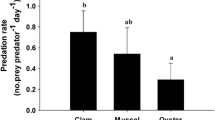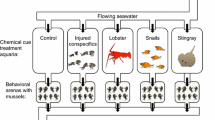Abstract
Predators such as crabs, whelks, and sea stars attack their bivalve prey in different ways, and predator-induced defenses are an important means of protection. The degree to which induced defenses are specific to different predators, however, remains largely unknown. In laboratory experiments (June to August 1998), we raised mussels (Mytilus edulis L.) in the presence of a drilling predator [the whelk Nucella lapillus (L.)] or a crushing predator [the crab Carcinus maenas (L.)] to determine whether induced changes in prey shell thickness, size, or shape occurred and whether changes were predator-specific. Over a 2 month period, juvenile mussels were exposed to waterborne cues from actively feeding crabs or whelks. Mussels produced thicker shell lips in response to both predators relative to control mussels raised in their absence, and the difference was significantly greater in response to whelks than to crabs. Mussels exposed to whelks showed significantly smaller increases in shell length and width and total wet weight than did mussels exposed to crabs. Thus, there may be a trade-off between shell thickness and linear shell growth and a potential delay in attaining a size refuge from predation.
Similar content being viewed by others
Author information
Authors and Affiliations
Additional information
Received: 4 August 1999 / Accepted: 31 January 2000
Rights and permissions
About this article
Cite this article
Smith, L., Jennings, J. Induced defensive responses by the bivalve Mytilus edulis to predators with different attack modes. Marine Biology 136, 461–469 (2000). https://doi.org/10.1007/s002270050705
Issue Date:
DOI: https://doi.org/10.1007/s002270050705




